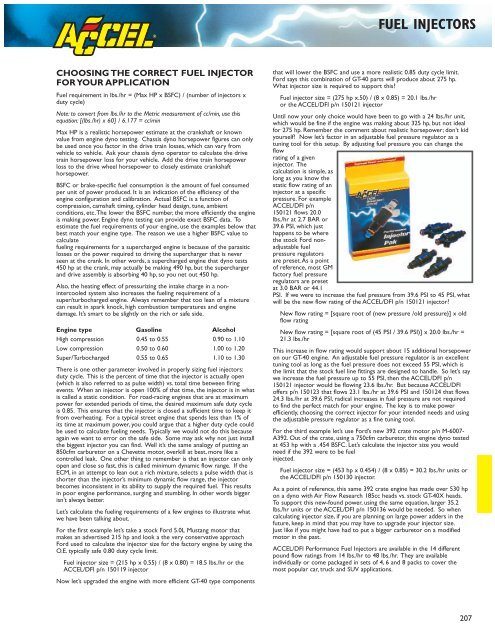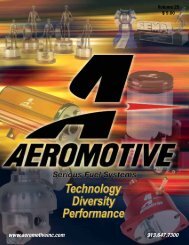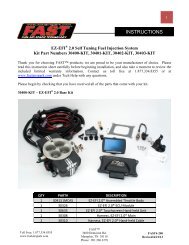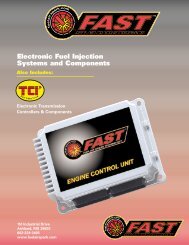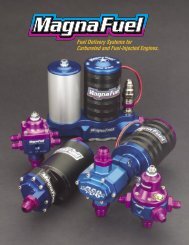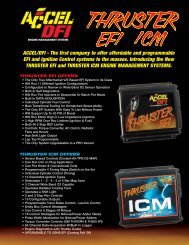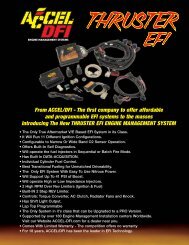to download an Accel DFI product catalog - efisupply.com
to download an Accel DFI product catalog - efisupply.com
to download an Accel DFI product catalog - efisupply.com
Create successful ePaper yourself
Turn your PDF publications into a flip-book with our unique Google optimized e-Paper software.
FUEL INJECTORS<br />
CHOOSING THE CORRECT FUEL INJECTOR<br />
FOR YOUR APPLICATION<br />
Fuel requirement in lbs./hr = (Max HP x BSFC) / (number of injec<strong>to</strong>rs x<br />
duty cycle)<br />
Note: <strong>to</strong> convert from lbs./hr <strong>to</strong> the Metric measurement of cc/min, use this<br />
equation: [(lbs./hr) x 60] / 6.177 = cc/min<br />
Max HP is a realistic horsepower estimate at the cr<strong>an</strong>kshaft or known<br />
value from engine dyno testing. Chassis dyno horsepower figures c<strong>an</strong> only<br />
be used once you fac<strong>to</strong>r in the drive train losses, which c<strong>an</strong> vary from<br />
vehicle <strong>to</strong> vehicle. Ask your chassis dyno opera<strong>to</strong>r <strong>to</strong> calculate the drive<br />
train horsepower loss for your vehicle. Add the drive train horsepower<br />
loss <strong>to</strong> the drive wheel horsepower <strong>to</strong> closely estimate cr<strong>an</strong>kshaft<br />
horsepower.<br />
BSFC or brake-specific fuel consumption is the amount of fuel consumed<br />
per unit of power produced. It is <strong>an</strong> indication of the efficiency of the<br />
engine configuration <strong>an</strong>d calibration. Actual BSFC is a function of<br />
<strong>com</strong>pression, camshaft timing, cylinder head design, tune, ambient<br />
conditions, etc.The lower the BSFC number, the more efficiently the engine<br />
is making power. Engine dyno testing c<strong>an</strong> provide exact BSFC data. To<br />
estimate the fuel requirements of your engine, use the examples below that<br />
best match your engine type. The reason we use a higher BSFC value <strong>to</strong><br />
calculate<br />
fueling requirements for a supercharged engine is because of the parasitic<br />
losses or the power required <strong>to</strong> driving the supercharger that is never<br />
seen at the cr<strong>an</strong>k. In other words, a supercharged engine that dyno tests<br />
450 hp at the cr<strong>an</strong>k, may actually be making 490 hp, but the supercharger<br />
<strong>an</strong>d drive assembly is absorbing 40 hp, so you net out 450 hp.<br />
Also, the heating effect of pressurizing the intake charge in a nonintercooled<br />
system also increases the fueling requirement of a<br />
super/turbocharged engine. Always remember that <strong>to</strong>o le<strong>an</strong> of a mixture<br />
c<strong>an</strong> result in spark knock, high <strong>com</strong>bustion temperatures <strong>an</strong>d engine<br />
damage. It’s smart <strong>to</strong> be slightly on the rich or safe side.<br />
Engine type Gasoline Alcohol<br />
High <strong>com</strong>pression 0.45 <strong>to</strong> 0.55 0.90 <strong>to</strong> 1.10<br />
Low <strong>com</strong>pression 0.50 <strong>to</strong> 0.60 1.00 <strong>to</strong> 1.20<br />
Super/Turbocharged 0.55 <strong>to</strong> 0.65 1.10 <strong>to</strong> 1.30<br />
There is one other parameter involved in properly sizing fuel injec<strong>to</strong>rs:<br />
duty cycle. This is the percent of time that the injec<strong>to</strong>r is actually open<br />
(which is also referred <strong>to</strong> as pulse width) vs. <strong>to</strong>tal time between firing<br />
events. When <strong>an</strong> injec<strong>to</strong>r is open 100% of that time, the injec<strong>to</strong>r is in what<br />
is called a static condition. For road-racing engines that are at maximum<br />
power for extended periods of time, the desired maximum safe duty cycle<br />
is 0.85. This ensures that the injec<strong>to</strong>r is closed a sufficient time <strong>to</strong> keep it<br />
from overheating. For a typical street engine that spends less th<strong>an</strong> 1% of<br />
its time at maximum power, you could argue that a higher duty cycle could<br />
be used <strong>to</strong> calculate fueling needs. Typically we would not do this because<br />
again we w<strong>an</strong>t <strong>to</strong> error on the safe side. Some may ask why not just install<br />
the biggest injec<strong>to</strong>r you c<strong>an</strong> find. Well it’s the same <strong>an</strong>alogy of putting <strong>an</strong><br />
850cfm carbure<strong>to</strong>r on a Chevette mo<strong>to</strong>r, overkill at best, more like a<br />
controlled leak. One other thing <strong>to</strong> remember is that <strong>an</strong> injec<strong>to</strong>r c<strong>an</strong> only<br />
open <strong>an</strong>d close so fast, this is called minimum dynamic flow r<strong>an</strong>ge. If the<br />
ECM, in <strong>an</strong> attempt <strong>to</strong> le<strong>an</strong> out a rich mixture, selects a pulse width that is<br />
shorter th<strong>an</strong> the injec<strong>to</strong>r’s minimum dynamic flow r<strong>an</strong>ge, the injec<strong>to</strong>r<br />
be<strong>com</strong>es inconsistent in its ability <strong>to</strong> supply the required fuel. This results<br />
in poor engine perform<strong>an</strong>ce, surging <strong>an</strong>d stumbling. In other words bigger<br />
isn’t always better.<br />
Let’s calculate the fueling requirements of a few engines <strong>to</strong> illustrate what<br />
we have been talking about.<br />
For the first example let’s take a s<strong>to</strong>ck Ford 5.0L Must<strong>an</strong>g mo<strong>to</strong>r that<br />
makes <strong>an</strong> advertised 215 hp <strong>an</strong>d look a the very conservative approach<br />
Ford used <strong>to</strong> calculate the injec<strong>to</strong>r size for the fac<strong>to</strong>ry engine by using the<br />
O.E. typically safe 0.80 duty cycle limit.<br />
Fuel injec<strong>to</strong>r size = (215 hp x 0.55) / (8 x 0.80) = 18.5 lbs./hr or the<br />
ACCEL/<strong>DFI</strong> p/n 150119 injec<strong>to</strong>r<br />
Now let’s upgraded the engine with more efficient GT-40 type <strong>com</strong>ponents<br />
that will lower the BSFC <strong>an</strong>d use a more realistic 0.85 duty cycle limit.<br />
Ford says this <strong>com</strong>bination of GT-40 parts will produce about 275 hp.<br />
What injec<strong>to</strong>r size is required <strong>to</strong> support this?<br />
Fuel injec<strong>to</strong>r size = (275 hp x.50) / (8 x 0.85) = 20.1 lbs./hr<br />
or the ACCEL/<strong>DFI</strong> p/n 150121 injec<strong>to</strong>r<br />
Until now your only choice would have been <strong>to</strong> go with a 24 lbs./hr unit,<br />
which would be fine if the engine was making about 325 hp, but not ideal<br />
for 275 hp. Remember the <strong>com</strong>ment about realistic horsepower; don’t kid<br />
yourself! Now let’s fac<strong>to</strong>r in <strong>an</strong> adjustable fuel pressure regula<strong>to</strong>r as a<br />
tuning <strong>to</strong>ol for this setup. By adjusting fuel pressure you c<strong>an</strong> ch<strong>an</strong>ge the<br />
flow<br />
rating of a given<br />
injec<strong>to</strong>r. The<br />
calculation is simple, as<br />
long as you know the<br />
static flow rating of <strong>an</strong><br />
injec<strong>to</strong>r at a specific<br />
pressure. For example<br />
ACCEL/<strong>DFI</strong> p/n<br />
150121 flows 20.0<br />
lbs./hr at 2.7 BAR or<br />
39.6 PSI, which just<br />
happens <strong>to</strong> be where<br />
the s<strong>to</strong>ck Ford nonadjustable<br />
fuel<br />
pressure regula<strong>to</strong>rs<br />
are preset.As a point<br />
of reference, most GM<br />
fac<strong>to</strong>ry fuel pressure<br />
regula<strong>to</strong>rs are preset<br />
at 3.0 BAR or 44.1<br />
PSI. If we were <strong>to</strong> increase the fuel pressure from 39.6 PSI <strong>to</strong> 45 PSI, what<br />
will be the new flow rating of the ACCEL/<strong>DFI</strong> p/n 150121 injec<strong>to</strong>r?<br />
New flow rating = [square root of (new pressure /old pressure)] x old<br />
flow rating<br />
New flow rating = [square root of (45 PSI / 39.6 PSI)] x 20.0 lbs./hr =<br />
21.3 lbs./hr<br />
This increase in flow rating would support about 15 additional horsepower<br />
on our GT-40 engine. An adjustable fuel pressure regula<strong>to</strong>r is <strong>an</strong> excellent<br />
tuning <strong>to</strong>ol as long as the fuel pressure does not exceed 55 PSI, which is<br />
the limit that the s<strong>to</strong>ck fuel line fittings are designed <strong>to</strong> h<strong>an</strong>dle. So let’s say<br />
we increase the fuel pressure up <strong>to</strong> 55 PSI, then the ACCEL/<strong>DFI</strong> p/n<br />
150121 injec<strong>to</strong>r would be flowing 23.6 lbs./hr. But because ACCEL/<strong>DFI</strong><br />
offers p/n 150123 that flows 23.1 lbs./hr at 39.6 PSI <strong>an</strong>d 150124 that flows<br />
24.3 lbs./hr at 39.6 PSI, radical increases in fuel pressure are not required<br />
<strong>to</strong> find the perfect match for your engine. The key is <strong>to</strong> make power<br />
efficiently, choosing the correct injec<strong>to</strong>r for your intended needs <strong>an</strong>d using<br />
the adjustable pressure regula<strong>to</strong>r as a fine tuning <strong>to</strong>ol.<br />
For the third example let’s use Ford’s new 392 crate mo<strong>to</strong>r p/n M-6007-<br />
A392. Out of the crate, using a 750cfm carbure<strong>to</strong>r, this engine dyno tested<br />
at 453 hp with a .454 BSFC. Let’s calculate the injec<strong>to</strong>r size you would<br />
need if the 392 were <strong>to</strong> be fuel<br />
injected.<br />
Fuel injec<strong>to</strong>r size = (453 hp x 0.454) / (8 x 0.85) = 30.2 lbs./hr units or<br />
the ACCEL/<strong>DFI</strong> p/n 150130 injec<strong>to</strong>r.<br />
As a point of reference, this same 392 crate engine has made over 530 hp<br />
on a dyno with Air Flow Research 185cc heads vs. s<strong>to</strong>ck GT-40X heads.<br />
To support this new-found power, using the same equation, larger 35.2<br />
lbs./hr units or the ACCEL/<strong>DFI</strong> p/n 150136 would be needed. So when<br />
calculating injec<strong>to</strong>r size, if you are pl<strong>an</strong>ning on large power adders in the<br />
future, keep in mind that you may have <strong>to</strong> upgrade your injec<strong>to</strong>r size.<br />
Just like if you might have had <strong>to</strong> put a bigger carbure<strong>to</strong>r on a modified<br />
mo<strong>to</strong>r in the past.<br />
ACCEL/<strong>DFI</strong> Perform<strong>an</strong>ce Fuel Injec<strong>to</strong>rs are available in the 14 different<br />
pound flow ratings from 14 lbs./hr <strong>to</strong> 48 lbs./hr. They are available<br />
individually or <strong>com</strong>e packaged in sets of 4, 6 <strong>an</strong>d 8 packs <strong>to</strong> cover the<br />
most popular car, truck <strong>an</strong>d SUV applications.<br />
207


